Quick Japanese cucumber pickles offer a revitalizing blend of tangy and savory flavors you can make in just 30 minutes. Start by slicing Japanese, Persian, or English cucumbers into thin rounds, then salt them for 10-20 minutes to remove excess moisture. Rinse and pat dry your cucumbers before combining them with a simple marinade of rice vinegar, water, sugar, and salt in a 1:1 ratio. Add optional ingredients like sesame oil, soy sauce, or chili flakes for extra depth. Your pickles will be ready to eat after 15 minutes of marination, though they'll develop more complex flavors the longer they rest.
Why Make Japanese Cucumber Pickles
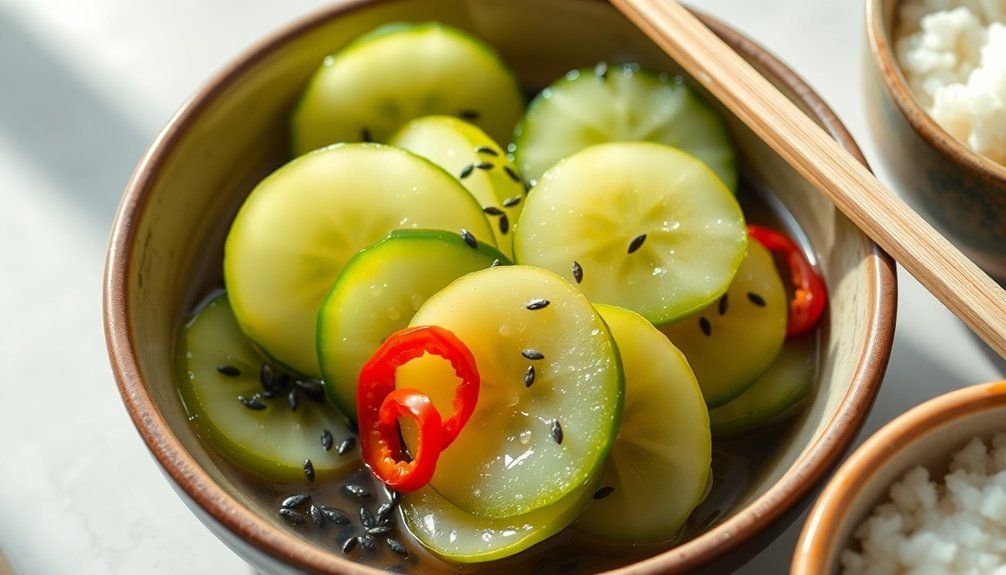
Versatility and nutrition make Japanese cucumber pickles a compelling addition to your culinary repertoire. You'll benefit from their exceptionally low caloric content, with only 35 calories per 30g serving, while getting significant nutritional value. They're completely free of fat and cholesterol, making them an ideal healthy snack option that helps you feel fuller longer. Research suggests they may have cancer-fighting properties, particularly against spleen cancer cells in laboratory studies.
The probiotic content in these pickles is particularly valuable for your gut health. They're rich in beneficial lactobacillus species that support digestion and maintain a healthy gut microbiome. If you're lactose intolerant, you might find these pickles especially helpful, as fermented foods can be easier to digest.
You'll also get important antioxidant protection, as the pickling process preserves these beneficial compounds. The beta-carotene content helps reduce your risk of various chronic conditions, including heart disease and type 2 diabetes.
They're an excellent source of vitamin K, providing 15-20% of your daily needs in just one serving. Plus, they're incredibly convenient to make and store, requiring only basic ingredients like rice vinegar, sugar, and water, while offering an extended shelf life in your refrigerator.
Essential Ingredients and Tools
You'll need basic equipment like a sharp knife or mandolin, a pickle press (or a weighted container), and storage containers to make proper Japanese cucumber pickles.
The fresh ingredients are straightforward: Japanese, Persian, or English cucumbers form the base, while rice vinegar, salt, and sugar create the essential pickling solution. Green onions and sesame seeds make excellent garnishes that add visual appeal and texture.
Key seasonings can include optional elements like sesame oil, soy sauce, or ginger to enhance the pickles' flavor profile.
Basic Pickling Equipment Needed
For successful Japanese cucumber pickles, gathering the right equipment and ingredients is your first essential step.
You'll need basic kitchen tools including a sharp knife, cutting board, and a rolling pin or heavy glass cup for smashing the cucumbers. Don't forget a chopping board specifically for salting and kitchen paper to dry the cucumbers after processing.
For the pickling process itself, you'll want to have a glass jar or container with a tight-fitting lid. If you don't have a jar, you can use a sealable bag as an alternative. Having multiple containers on hand allows you to experiment with different vinegar types for unique flavor profiles.
You'll also need a medium or large bowl for mixing your pickling liquid, along with a whisk to properly dissolve the sugar and combine your ingredients.
When it comes to mixing and serving, make certain you've got a spoon or spatula for tossing the cucumbers in the pickling liquid.
If you're planning to ferment your pickles, you'll need a pickle press or weight to keep the cucumbers submerged.
For storage, verify your container is refrigerator-safe, and have some serving dishes ready for when it's time to enjoy your pickles.
Fresh Ingredients List
With your equipment ready, selecting fresh, high-quality ingredients will set the foundation for outstanding Japanese cucumber pickles. You'll want to start with Japanese, Persian, or English cucumbers for their crisp texture and minimal seeds. Japanese cucumbers (kyuri) are particularly suitable for their superior crunch and reliability.
For best results, you'll need these fresh components carefully prepared:
| Main Ingredients | Preparation Method |
|---|---|
| Cucumbers | Slice 1/8-inch thick, salt for 10-30 minutes |
| Green Onions | Dice or thinly slice |
| Fresh Herbs | Optional, prepare just before use |
| Garnishes | Toast sesame seeds if using |
After slicing your cucumbers, you'll salt them to draw out excess moisture, which helps maintain their crunch. Rinse the salted cucumber slices thoroughly and pat them dry with paper towels before proceeding. If you're adding heat to your pickles, prepare your chosen chilies or pepper flakes. Remember to slice your green onions just before mixing to maintain their fresh flavor. While optional, having sesame seeds ready for garnishing will add both visual appeal and a nutty flavor to your finished pickles.
Key Seasonings And Vinegars
The foundation of authentic Japanese cucumber pickles lies in the careful selection and balanced combination of seasonings and vinegars. Rice vinegar serves as the primary pickling agent, offering a mild and slightly sweet flavor that you can adjust by mixing with water.
You'll want to pair it with soy sauce, which adds essential umami and saltiness to your pickles.
For the perfect balance of flavors, you'll need these key components:
- Rice vinegar (¼ cup): Use either plain or seasoned variety, adjusting the amount based on your taste preference
- Soy sauce (1-2 tablespoons): Choose regular or low-sodium options to control salt levels
- Sugar (1-2 teaspoons): Helps balance the sour and salty elements while aiding in seasoning dissolution
- Sesame oil (1 teaspoon): Adds a distinctive nutty flavor that's characteristic of Japanese pickles
You can enhance your pickles further with optional ingredients like fresh ginger strips, chili paste, or sesame seeds.
Remember to store your seasoning mixture in an airtight container if you're making extra for future batches. When combining these seasonings, start with smaller amounts and adjust to your taste, as some ingredients like sesame oil can be quite potent.
Choosing the Right Cucumbers
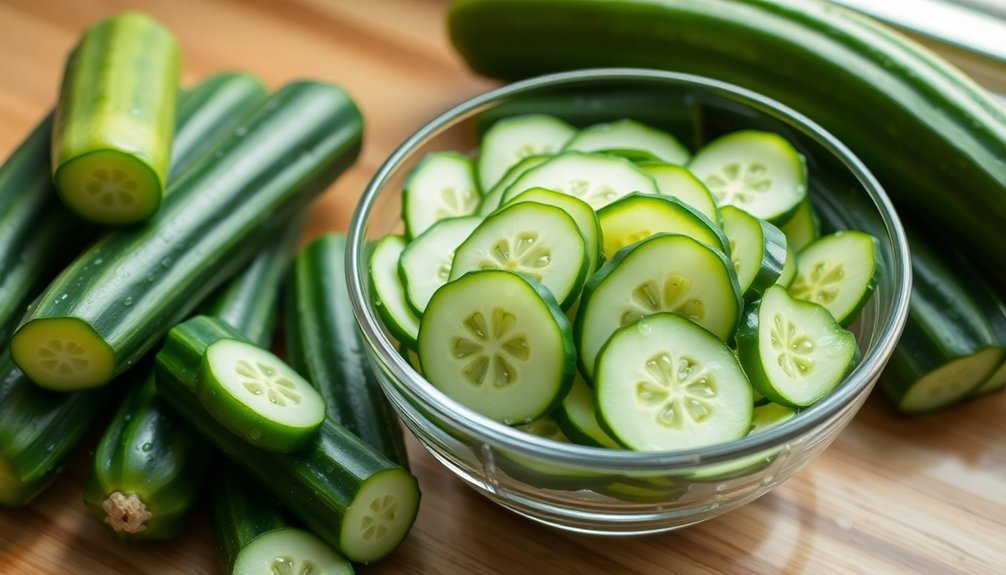
You'll want to select fresh, firm cucumbers over older ones, as they'll provide better crunch and flavor in your Japanese pickles.
For the best results, choose seedless varieties like Japanese or mini seedless cucumbers, which eliminate the need for seed removal and guarantee consistent pickling.
The skin texture of your chosen cucumber matters greatly – Japanese cucumbers with their slightly bumpy skin offer ideal pickling qualities, while English cucumbers may need their watery centers removed.
Fresh vs. Older Cucumbers
Successfully pickling Japanese cucumbers starts with selecting the right cucumber at the right stage of maturity. Fresh cucumbers are your best choice, ideally used within 24 hours of harvest. They'll give you the crisp texture and clean flavor that's vital for Japanese-style pickles, with thinner skin and fewer seeds than their older counterparts.
While older cucumbers can work for some pickle styles, they're not ideal for Japanese quick pickles. Older specimens tend to be softer, more bitter, and often have tougher skin and larger seeds that can detract from the delicate balance of flavors in Japanese pickles.
- Fresh cucumbers should be light to medium green with bumpy, spiny skin.
- Pick or purchase cucumbers that measure 1.25-1.75" across for ideal slicing.
- Avoid waxed cucumbers, as they won't properly absorb the vinegar solution.
- Store cucumbers in your refrigerator's crisper drawer if you can't pickle them immediately.
If you're working with older cucumbers, consider using them for relishes or bread-and-butter style pickles instead, where texture isn't as significant.
For authentic Japanese pickles, stick with fresh, firm cucumbers harvested early in the day.
Seedless Varieties Matter
Building on the importance of fresh cucumbers, selecting seedless varieties takes your Japanese pickles to the next level. Japanese burpless-type cucumbers, known as kyuri, are ideal for quick pickling due to their naturally seedless nature and thin skin.
You'll find these varieties have fewer and smaller seeds, making them perfect for creating crisp, uniform pickles without the need to remove seeds or deal with bitter flavors.
These parthenocarpic cucumbers offer several advantages for your pickling projects. They're naturally sweeter due to lower cucurbitacin levels, and you won't need to scrape out the center as you might with English cucumbers.
Varieties like Burpless Beauty and Garden Sweet Burpless Hybrid work well for both fresh eating and pickling, producing consistent, high-quality fruits with bright green exteriors.
If you're growing your own, you can plant these varieties from March to July. They'll thrive in either greenhouse or outdoor settings, but remember to provide proper support with trellises.
The plants are naturally resistant to common diseases like CMV, and you'll get a longer harvest window with more marketable fruits per plant compared to standard varieties.
Skin Texture Types
Selecting the right cucumber skin texture fundamentally impacts your Japanese pickle results. Japanese cucumbers typically feature a slightly bumpy skin that's ideal for pickling, as it allows the vinegar mixture to cling better to the surface. While you can use other varieties, understanding skin texture differences will help you achieve authentic results.
For Japanese-style pickles, you'll want to evaluate these key texture factors:
- Bumpy skin varieties like Japanese or Kirby cucumbers will give you the most traditional results, as their texture helps them maintain crispness.
- Thin-skinned varieties such as English or Persian cucumbers work well if you prefer a more delicate pickle texture.
- Smooth-skinned varieties can be used but may not absorb the pickling liquid as effectively.
- Thick-skinned pickling cucumbers are suitable alternatives, though they'll produce a heartier final texture.
If you can't find Japanese cucumbers, opt for Kirby or Persian varieties with similar bumpy characteristics.
You'll want to avoid heavily waxed garden cucumbers, as the coating interferes with the pickling process.
Remember that thinner-skinned varieties may pickle faster, so you'll need to adjust your timing accordingly.
Preparing Your Pickling Liquid
The pickling liquid serves as the heart of Japanese cucumber pickles, combining essential ingredients like rice vinegar, sugar, sesame oil, soy sauce, and salt. You'll want to whisk these ingredients together in a bowl until the sugar and salt completely dissolve, creating a balanced blend of sweet, salty, and tangy flavors.
To enhance your pickling liquid, you can incorporate optional ingredients that add depth and complexity. Consider adding instant dashi powder for umami richness or a splash of fresh lemon juice for brightness.
If you're seeking traditional Japanese flavors, try adding a strip of konbu (dried kelp) or using shiro dashi as your base.
For best results, you can either let the mixture sit at room temperature to meld the flavors or gently heat it to help the sugar and salt dissolve more quickly. If you choose to heat the liquid, make sure it's completely cooled before using.
You can also customize your pickling liquid by adding sesame seeds, green onion slices, or dried red chilies for extra flavor and visual appeal. The finished liquid should be clear and well-combined before you use it for pickling.
Salt Treatment Methods
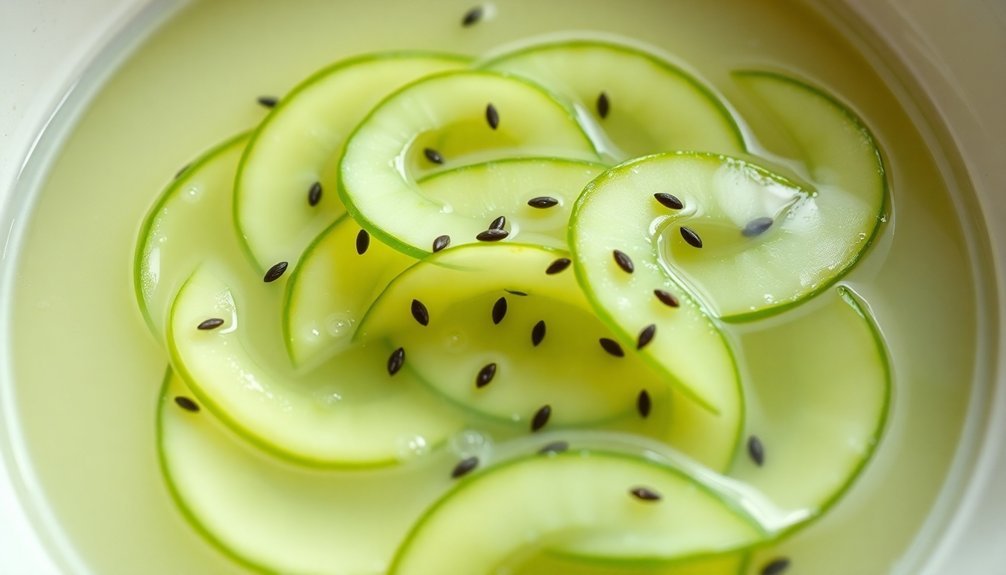
Four essential salt treatment methods form the foundation of Japanese cucumber pickles: direct salting, short salting, salt solution soaking, and immediate rubbing.
You'll want to choose thin-skinned cucumbers like English, Persian, or Japanese varieties for the best results. For basic direct salting, use 1 teaspoon of salt per cup of thinly sliced cucumbers and let them sit for 10-30 minutes before rinsing.
If you're short on time, try the quick salting method, which takes just 30 minutes and works well for various vegetables. For a more traditional approach, you can soak your cucumber batons in a salt solution for two hours.
The immediate rubbing method involves massaging salt directly into the cucumber surfaces, which quickly draws out moisture.
- Direct salting ratio: 1 tsp salt per cup of cucumbers, rest 10-30 minutes
- Short salting time: 5 minutes prep + 30 minutes marination
- Salt solution mix: 2 1/2 cups water + 1 tbsp salt, soak for 2 hours
- Immediate rubbing method: Apply salt directly and massage, then press
Remember to rinse your cucumbers 2-3 times after any salting method to achieve your desired saltiness level.
You'll know you've done it right when the cucumbers are crisp and flavorful.
Slicing Techniques for Cucumbers
Now that you've mastered salt treatments, proper slicing techniques will determine your pickles' final texture and appearance. For traditional Japanese pickles, you'll want to focus on creating uniform rounds or crescents that will absorb the vinegar solution evenly.
Start by selecting a sharp chef's knife and keeping the cucumber skin on to prevent slipping. For rounds, slice the whole cucumber into ¼-inch thick pieces after trimming the ends. If you're aiming for crescents, cut the cucumber lengthwise first, then slice each half into even pieces.
If you'd prefer seedless pickles, halve the cucumber lengthwise and remove the seeds with a spoon before slicing. Place the flat side down on your cutting board for stability.
For a different texture, you can create thin batons by quartering the cucumber lengthwise and cutting into sticks.
For finely diced pickles, quarter the cucumber, remove seeds, and cut into thin planks. Then slice these planks into sticks before cross-cutting into ½-inch or smaller dice.
Whatever style you choose, maintaining consistent thickness guarantees your pickles will cure evenly.
Perfect Pickling Ratios
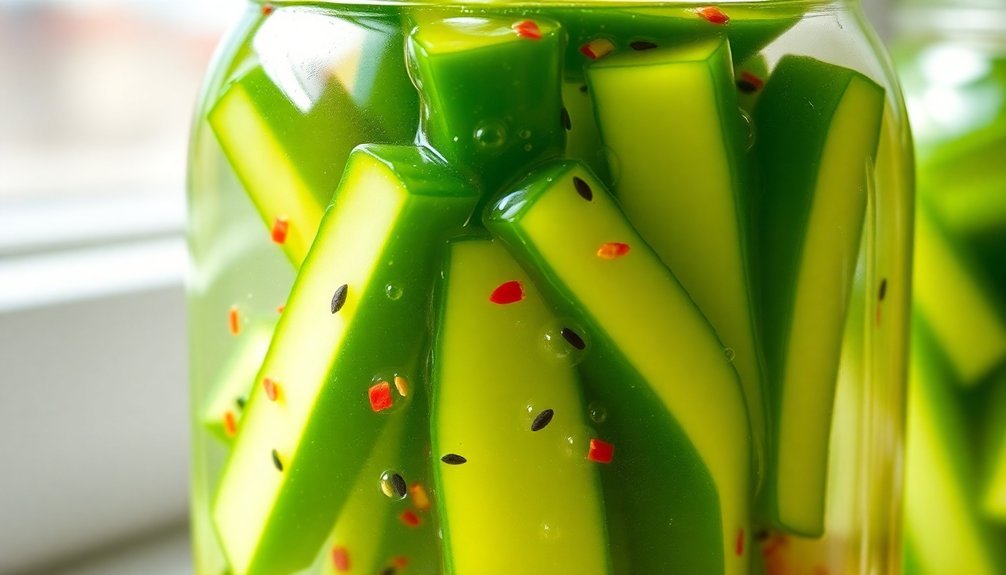
Creating perfectly balanced Japanese cucumber pickles comes down to precise ratios of rice vinegar, water, sugar, and salt. The standard mixture combines rice vinegar and water in either a 1:2 or 1:1 ratio, depending on how strong you'd like the vinegar flavor.
For every cup of rice vinegar, you'll need 1/4 to 1 tablespoon of sugar and 1-2 teaspoons of salt to achieve that characteristic sweet-sour balance.
- Start with a basic 1:2 vinegar-to-water ratio for milder pickles, or increase to 1:1 for a more pronounced tang.
- Add 1 tablespoon of sugar per cup of rice vinegar to balance the acidity.
- Mix in 1-2 teaspoons of salt to draw moisture from the cucumbers and enhance flavor.
- Consider optional additions like 2 tablespoons soy sauce, 1 teaspoon sesame oil, or 1 teaspoon chili paste.
You can adjust these ratios to suit your taste preferences.
If you're looking to enhance the flavor profile, try incorporating small amounts of dashi powder or a splash of lemon juice.
Remember that longer marination times will result in stronger flavors, though 15 minutes is sufficient for a quick pickle.
Traditional Japanese Flavor Additions
Beyond the basic pickling solution, traditional Japanese cucumber pickles gain their distinctive character from a carefully chosen array of flavor additions. You'll find that Japanese sea salt and soy sauce form the umami foundation, while rice vinegar provides the essential tangy notes. Sugar helps balance these strong flavors, creating a harmonious blend.
For aromatic depth, you can incorporate fresh ginger, shiso leaves, or myoga. These ingredients aren't just flavor enhancers – they're integral to achieving that authentic Japanese pickle taste. If you're looking to add heat, consider togarashi or karashi mustard, which provide different levels of spiciness.
| Flavor Category | Key Ingredients |
|---|---|
| Base Seasonings | Sea salt, Soy sauce |
| Aromatics | Ginger, Shiso, Myoga |
| Spicy Elements | Togarashi, Karashi |
| Citrus Notes | Yuzu zest, Mikan peel |
| Texture Add-ins | White sesame seeds, Rice bran |
Don't forget the finishing touches – a sprinkle of toasted sesame seeds or a drizzle of sesame oil can transform your pickles from good to exceptional. For a citrusy brightness, try adding yuzu or mikan zest, which perfectly complement the vinegar's acidity.
Quick Marination Tips
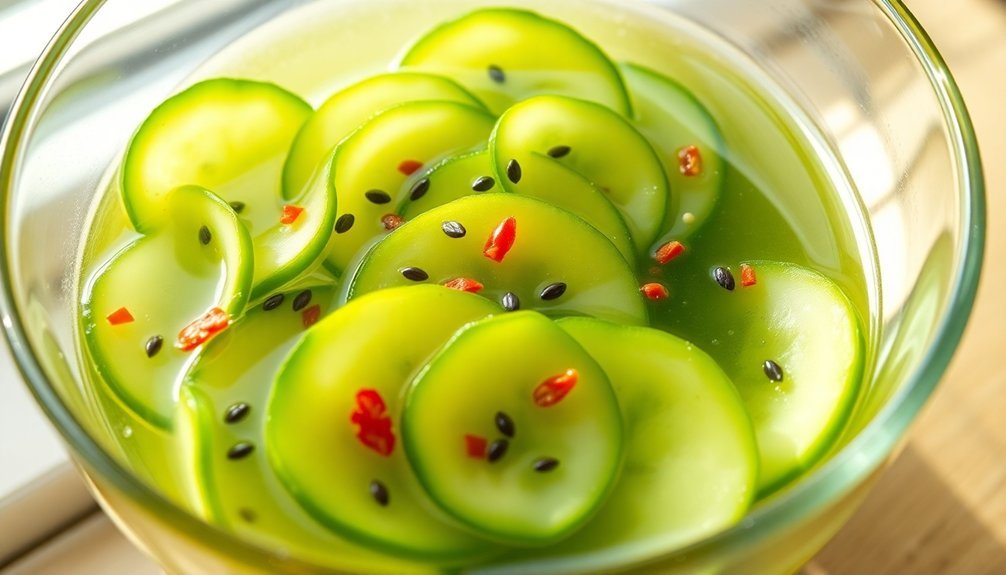
For successful quick-marinated cucumber pickles, proper preparation and timing are essential. You'll want to start by slicing your cucumbers uniformly at 1/8-inch thickness to guarantee they'll absorb the marinade evenly. After salting them for 10-20 minutes to draw out excess moisture, you're ready to begin the quick pickling process.
To achieve the best results during quick marination, follow these key steps:
- Combine rice wine vinegar, water, soy sauce, and a touch of sesame oil in your marinade bowl, making sure the proportions are balanced for ideal flavor.
- Fully submerge your prepared cucumber slices in the cold marinade, ensuring they're completely covered.
- Let them marinate for 15-30 minutes at room temperature, stirring gently to coat all surfaces.
- Taste test at the 15-minute mark and adjust seasonings as needed.
You can enhance the flavor profile during the quick marinade by adding aromatics like minced garlic or ginger paste.
Don't forget to garnish with sesame seeds or chopped green onions just before serving. While longer marination will intensify flavors, these quick-pickled cucumbers are ready to enjoy within 30 minutes.
Storing Your Pickled Cucumbers
Store your Japanese cucumber pickles in an airtight container, making sure they're completely covered with the pickling liquid to maintain their freshness.
You'll get the best results using clean, wide-mouth mason jars that allow easy access and proper sealing to prevent bacterial growth.
Keep your pickles refrigerated for up to two weeks, but for ideal flavor, try to enjoy them within 2-3 days of preparation.
Refrigeration Tips and Duration
When you've prepared your Japanese cucumber pickles, proper storage becomes essential for maintaining their crisp texture and vibrant flavors.
For quick pickles made with rice vinegar, you'll want to consume them within 1-2 days for the best taste and quality. If you've used soy sauce and additional ingredients in your pickling solution, you can extend the storage time to 10-12 days in the refrigerator.
To maximize the shelf life of your Japanese cucumber pickles, follow these important refrigeration guidelines:
- Remove the pickles from the original pickling liquid and transfer them to a clean, airtight container before refrigerating.
- Store your pickles at a consistent cold temperature, away from direct light to preserve their freshness.
- Use clean utensils whenever handling the pickles to prevent bacterial contamination.
- Check regularly for any signs of spoilage, such as unusual odors or slimy texture.
Remember that pickles made with higher salt content will generally last longer, but those prepared with mild rice vinegar have a shorter shelf life.
Keep your container sealed tightly to prevent air exposure, and you'll maintain the pickles' quality throughout their storage period.
Airtight Container Best Practices
Proper containers make all the difference when storing your Japanese cucumber pickles. You'll want to choose nonreactive containers, with glass Mason jars being your best option. If you're using plastic, make sure it's food-grade quality, and avoid metal containers that can react with the vinegar. Before storing your pickles, verify your container is completely clean and dry.
Select a nonreactive lid made from glass, stainless steel, or food-grade plastic, and check that it creates a tight seal. If you're using canning lids, remove the ring after sealing to prevent rust formation. Before securing the lid, wipe the container's rim clean to avoid any sealing problems.
You'll need to pour off excess liquid before storing to keep your pickles crisp. Always use clean utensils when handling them to prevent contamination.
Store your containers in the refrigerator, keeping them away from strong-smelling foods that could affect their flavor. Don't forget to label and date your containers so you can track their freshness.
Check your pickles regularly for any signs of spoilage or mold, and keep the containers' exteriors clean and dry to prevent moisture buildup.
Serving Suggestions and Pairings
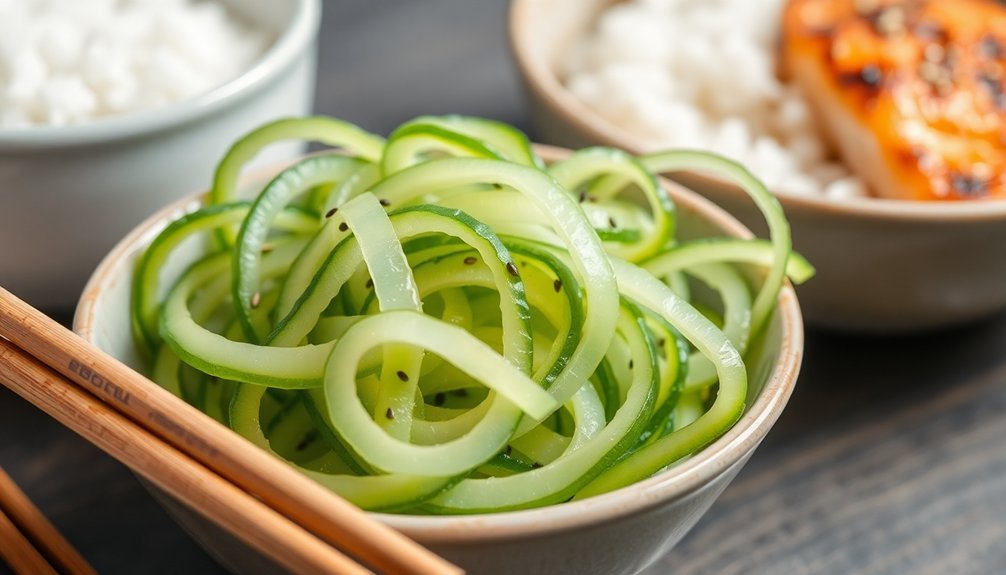
Japanese cucumber pickles complement countless traditional and contemporary dishes, making them a versatile addition to any meal.
You'll find they're particularly delightful alongside Japanese mains like miso chicken, chicken katsu, or nikujaga. They're also perfect with fusion dishes, especially Hawaiian-Japanese combinations and modern interpretations like poke bowls.
These invigorating pickles work wonderfully as a palate cleanser between courses or as a crunchy side dish. You can serve them chilled to add a crisp contrast to warm main dishes, or enjoy them as a standalone snack.
They're especially good with rice-based meals and Asian-style sandwiches.
Here are four key ways to incorporate these pickles into your meals:
- Pair with donburi bowls like butadon or teriyaki salmon for a balanced meal
- Serve alongside heavy dishes like kurobuta pork chop to cleanse the palate
- Add to bento boxes or lunch plates as an invigorating side
- Include in Asian fusion meals for an authentic touch
For the best experience, serve your pickles immediately after preparation or chilled from the fridge, ensuring they maintain their crisp texture and vibrant flavor.
Recipe Variations and Modifications
Creative home cooks can explore numerous variations of traditional Japanese cucumber pickles by adjusting ingredients and preparation methods.
You'll find that adding soy sauce deepens the umami flavor, while incorporating shredded ginger introduces a spicy, aromatic element. For adventurous palates, try mixing in wasabi, chili peppers, or instant dashi powder to create unique flavor profiles.
You can modify the texture by varying your cutting techniques. Try slicing the cucumbers thinly for quick-pickled dishes, or smash them using the Tataki Kyuri method for better brine absorption.
If you're short on time, opt for a quick 20-minute pickle, but for more intense flavors, let them brine overnight.
To enhance the visual appeal and add complexity, you'll want to experiment with different garnishes. Toast sesame seeds before sprinkling them over your pickles, or add vibrant chili flakes for color contrast.
Don't hesitate to adjust the sugar-to-vinegar ratio to match your taste preferences. You can also create fusion versions by incorporating non-traditional ingredients like beer or different vinegar types while maintaining the essential Japanese pickling techniques.
Frequently Asked Questions
Can I Use Regular White Vinegar Instead of Rice Vinegar?
You can use white vinegar instead of rice vinegar, but you'll need to reduce the amount and add sugar to balance its sharper taste. The flavor won't be identical, but it'll work in a pinch.
Why Do My Pickled Cucumbers Become Soggy After a Few Days?
Your pickles likely become soggy because you're not properly draining the cucumbers before pickling, using incorrect cucumber types, or storing them too long. Make sure you're salting and drying them thoroughly before pickling.
Is It Necessary to Sterilize Jars for Quick-Pickled Cucumbers?
For quick-pickled cucumbers you don't need to sterilize jars if you'll eat them within a few weeks. However, it's still smart to wash your containers in hot, soapy water for basic food safety.
Can Pregnant Women Safely Eat These Pickled Cucumbers?
You can safely eat quick-pickled cucumbers while pregnant if they're stored in the refrigerator and consumed within a week. Just be mindful of your sodium intake and avoid homemade shelf-stable pickles.
Why Does the Pickling Liquid Sometimes Turn Cloudy?
Your pickling liquid can turn cloudy due to minerals in hard water, using table salt with anti-caking agents, or from ground spices. If you're fermenting pickles, cloudiness is normal and indicates active cultures.
In Summary
You'll find these quick Japanese cucumber pickles are the perfect solution for using up garden cucumbers and adding a revitalizing crunch to your meals. They're incredibly versatile – serve them alongside rice, in sandwiches, or as part of a traditional Japanese spread. With just a few simple ingredients and minimal effort, you've got a healthy, flavorful side dish that'll keep in your fridge for several days.

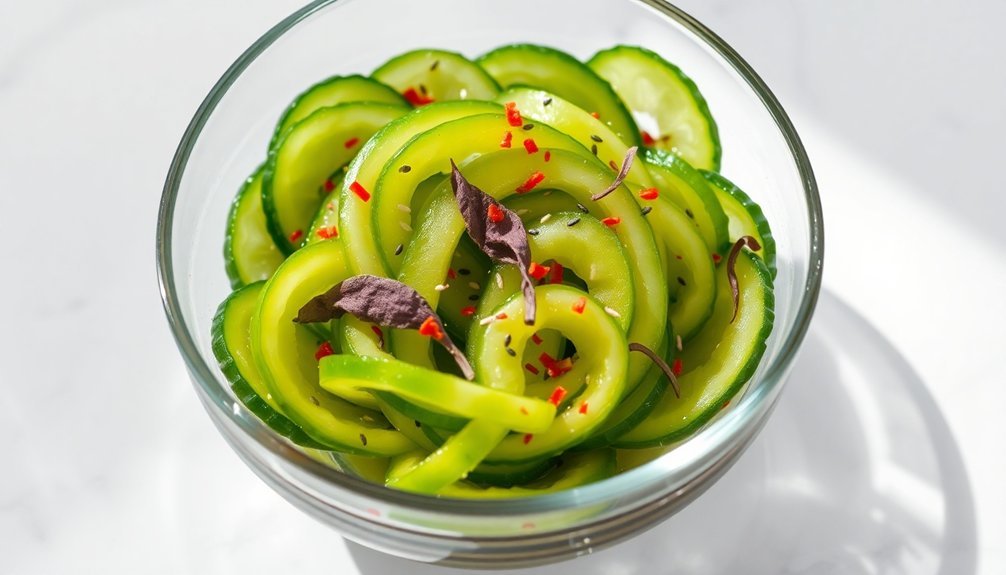



Leave a Reply